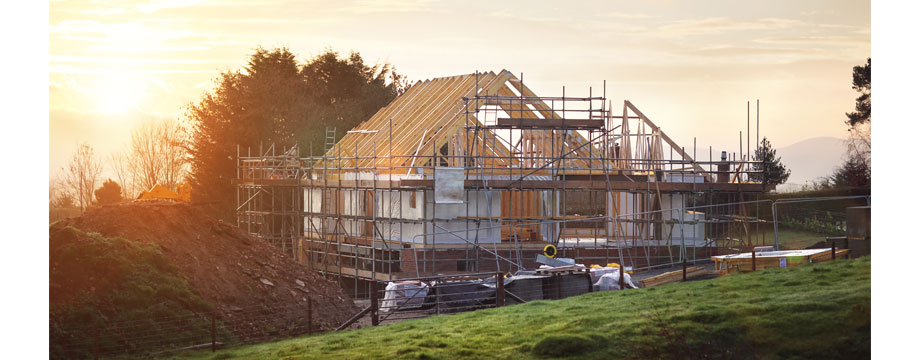TV presenter and architect, George Clarke looks at the lessons we can all learn from the UK’s intrepid self-builders

I love self-build housing. I love self-build housing for a number of very important, but simple reasons.
If someone has the opportunity to self-build their own home, a place they want to live for many years rather than build-to-sell to make a quick profit, then they put their hearts and souls into it.
They care about it so much that they are willing to build something very, very good.
It may even be of a design that is unique and a welcome reaction to the sterile, repetitive blandness often associated with some of the big house builders.
Self-builders also go the extra mile when it comes to sustainable and ecological design.
I’ve done it myself on every single home I’ve built for myself since I was 25 years old.
I go the extra mile, way beyond the requirements of the building regulations (which are a minimum standard by the way……you can go beyond them!) by adding more and more insulation, sometimes installing triple-glazing into my windows rather than double-glazing and specifying materials of a high quality because I want to build to last.
And self-builders very rarely compromise on quality or cut corners.
WHY? Because why would you cut corners on anything to do with your own home; the most important piece of architecture in your personal life and a place you want to raise your kids and entertain your grandkids in safety and comfort (and ideally surrounded by something beautiful) for many years to come.
The most simple point to make is that, for obvious reasons, self-builders care more about the home they build because its theirs!
Self-builders are more passionate and interested in taking a long-term approach to environmental design and will allocate a decent proportion of their self-build budget to invest in ground source heat-pumps or air source heat pumps to generate the heat they need for heating and hot water.
They will also consider solar and wind power, not just because its the right thing to do for the planet, but because they want to reduce their long-term energy bills, which will only increase massively as fossil-fuel prices sky-rocket.
A cleaner, greener low-carbon future for housing is absolutely at the forefront of a self-builder’s busy mind.
It is also true that self-builders often build better quality homes on a more affordable budget as they invest so much of their own time, their own skills and the skills of friends and family to help get the home they are so emotionally invested in over the line.
 Better and more affordable?
Better and more affordable?
When the government is pushing to ‘Build better, build beautiful’ then surely self-build is one of the best ways to achieve this.
We are also very good at self-building homes in Britain.
The standard and quality of so many our self-build projects are celebrated, not only in this country, but across the globe.
We even make very successful TV programmes about UK self-builders, programmes that are exported to distant parts of the planet. Think about Grand Designs with Kevin McCloud, it is one of the most successful exports in British Television and it is as popular today as when it started over 20 years ago.
If it wasn’t for that series, I don’t think I would have been inspired enough to even have my own career in television, but no other programmes about self-building got me buzzing as much as Grand Designs did.
In the UK the great British public design and self-build around 13,000 homes per year. This sounds impressive and in some ways it is.
If that number of homes was built by a single property development company then they would be in the top 4 or 5 in the league table of big house-builders.
I have to say though I’d rank them number one in terms of quality, because I’d prefer 13,000 high quality homes rather than a greater number of more sterile, bland and endlessly repetitive ‘noddy-boxes’.
So, the self-build industry has a lot to be proud of, particularly when it comes to excelling in very high levels of ecological and sustainable design.
Self-building can also be done at scale with innovative community-led projects that are created from the bottom up, rather than top down. All good stuff.
The big problem is the self-build industry should be bigger. Much bigger.
Self-builders still only represent a relatively small proportion of the overall industry, around 7-10% a year.
Self-building is a much bigger percentage in many developed overseas countries. Numbers fluctuate from year to year as you can imagine, but generally around 30% of homes built in Sweden are self build, in France it is around 38%, in Hungary its around 52%, in Germany its 55% and in Austria its even more!
“A cleaner, greener low-carbon future for housing is absolutely at
the forefront of a self-builder’s busy mind.... self-builders often build better
quality homes on a more affordable budget...”
So, we can and need to do so much more to increase the opportunities for people to build their own home in Britain.
Thankfully Boris Johnson (who has just resigned as I’m writing this!) realised more needs to be done and commissioned the Richard Bacon Review that was published in the summer of 2021.
(It is worth pointing out though that when Grant Shapps was appointed housing minister in 2010, he shortly after pushed hard for a self-build revolution in the UK, I attended the launch in Downing Street myself to lend my support, and very little has actually happened in the last 12 years!)
Anyway, the Bacon Review makes all the right noises and should be celebrated. It is worth listing out the recommendations Richard Bacon has made to government for the avoidance of any doubt:
Recommendation 1:
Greater role for Homes England
The Government should create a new Custom and Self-Build Housing Delivery Unit within Homes England to enable the creation of serviced building plots on small and large sites and support the delivery of custom and self-build housing at scale across the country.
Recommendation 2:
Raise Awareness of the Right to Build
The Government, working through Homes England in partnership with the custom and self-build industry, should create a custom and self-build housing Show Park and should strengthen existing legislation to mandate the wider publicity of Self-build and Custom Housebuilding Registers and the sharing of key data between willing landowners and people on registers.
Recommendation 3:
Support Community-Led Housing, Diversity of Supply and Levelling Up
The Government should reignite the successful Community Housing Fund; create accessible opportunities for communities to help themselves by introducing a Self-Help Housing Programme; and introduce a Plot to Rent Scheme.
Recommendation 4:
Promote Greener homes and more use of advanced manufacturing
The Government should recognise and support the pathfinding role of the custom and self-build housing sector in advanced manufacturing and in greener homes to accelerate the delivery of its wider Modern Methods of Construction and Net Zero Housing ambitions.
Recommendation 5:
Support Custom and Self-build housebuilding through the Planning Reforms
The Government should ensure that the planning reforms in its White Paper Planning for the future maximise the opportunities for access to permissioned land for CSB across all tenures, including making focussed changes to the Right to Build legislation to ensure that it achieves its objectives.
Recommendation 6:
Iron out any tax creases
The Government should investigate the perceived disadvantages in the tax system between the CSB delivery model and other forms of housing, identifying specific actions where necessary to neutralise them.
As the lights dim on Boris Johnson’s political career, the Bacon Review will no doubt be thrown in the bin because it was commissioned under Boris’ tenure and not by his successor (They all want to do their own thing rather than doing the right thing!).
However, I live in hope that there will be significant change in the UK to allow more people to self-build very beautiful homes to a much higher ecological standard than the big house builders do.
Watch this green space.
George Clarke is an Architect, writer, TV presenter and Ecodan Ambassador. This article and other blog’s by George Clarke appear regularly on Mitsubishi Electric’s The Hub, visit les.mitsubishielectric.co.uk/the-hub
- Log in to post comments













